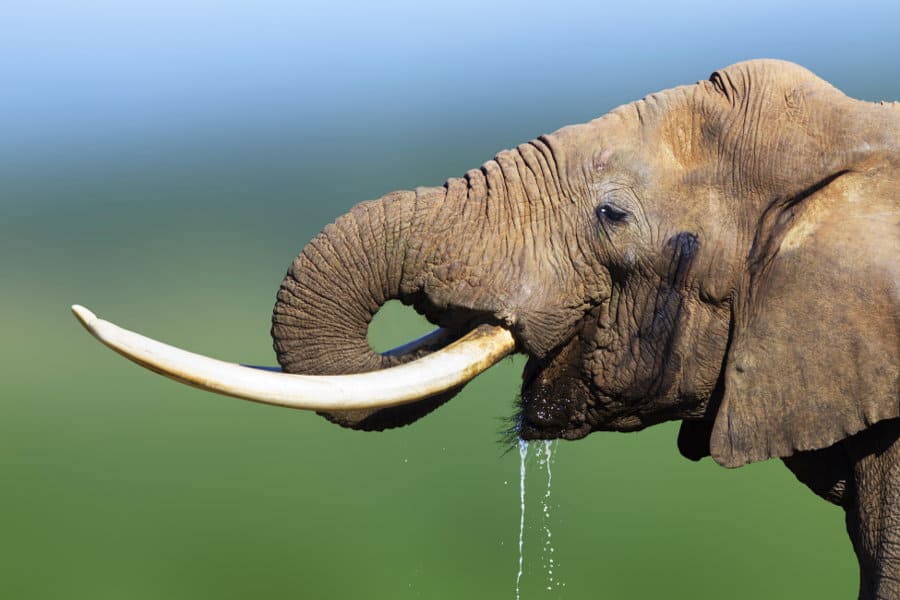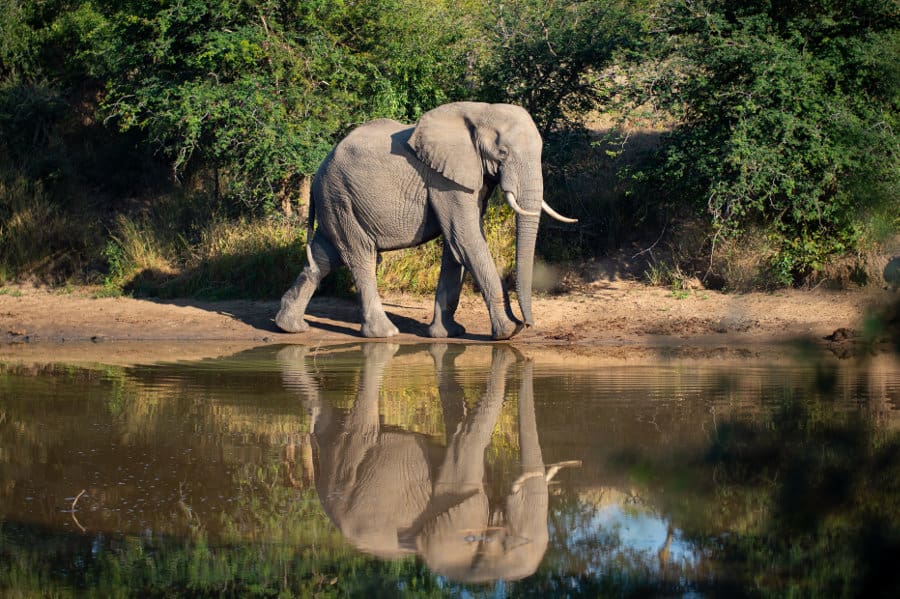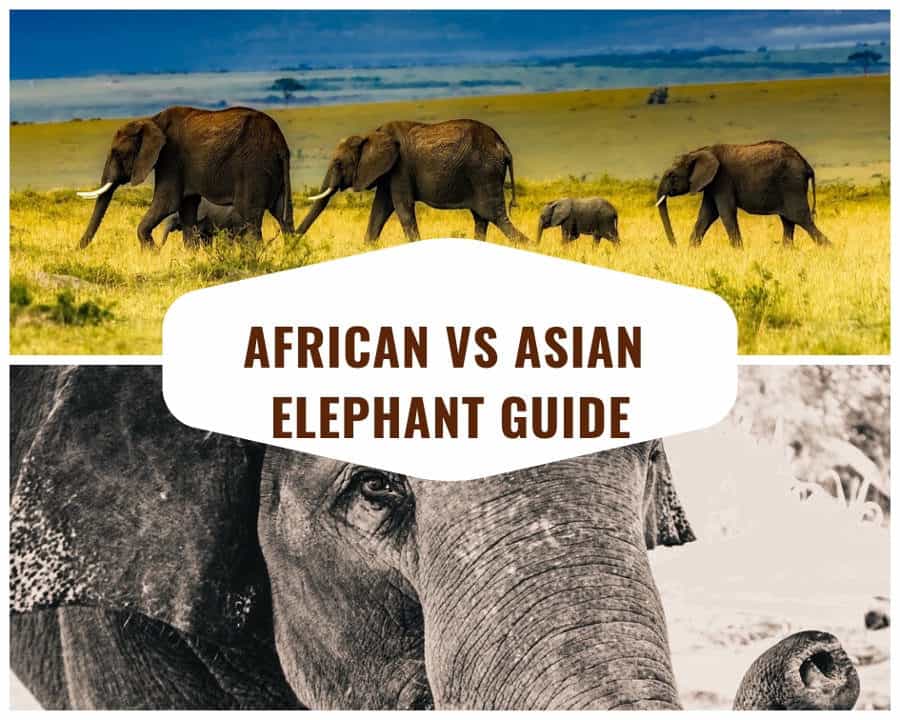The average adult African elephant weighs up to 7 tons, making them the heaviest land animal on earth. The Asian elephant is slightly more petite, reaching a maximum weight of 5 tons.
Despite their gigantic size, elephants are surprisingly graceful. A herd is capable of passing by a human campsite almost completely undetected because they’re so quiet (when they choose to be).
So even though elephants weigh a lot, they’re not the clumsy giants some expect them to be. Read on for the complete story on how much does an elephant weigh (in tons). In addition to the elephant’s weight, check out these incredible African elephant facts.
How Much Do Elephants Weigh?
That depends on which elephant you are talking about. There are two species of elephants found in the world: African and Asian elephants.
How much does an African elephant weigh?
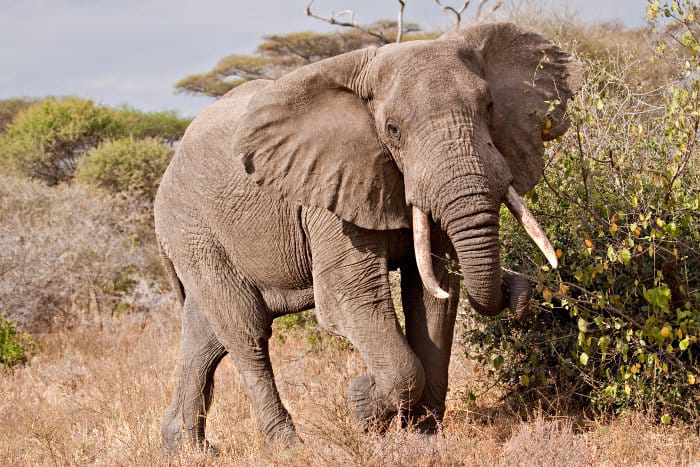
African elephants are the giants, even by elephant standards. An adult male can carry a full 6 tons with gentle grace. Generally, the females are slightly more petite; however, they can still weigh in at a whopping 3.6 tons or more sometimes.
How do they acquire such impressive robustness on a diet of plants in terrain where food can sometimes be scarce? Well, they graze all day, every day.
In fact, grazing is such a large part of their daily habits they typically spend about 12-18 hours per day foraging for food. Their bodies are well-adapted to sourcing nutrition in unusual places, enabling them to survive in conditions that can range from arid and dusty to lush woodlands.
What is an Asian elephant’s weight (in tons)?
It weighs a little less than its African cousin, reaching a maximum weight of four or five tons (as opposed to the African elephant’s six or seven tons). An adult male Asian elephant can start at around two tons.
The female Asian elephants are different. They weigh anywhere from two tons to three-and-a-half tons. Although this may seem a lot less than the African elephant, don’t be fooled; they still weigh more than some cars on the market today.
The Asian elephant is classified as an endangered species, with between forty thousand and fifty thousand remaining in their natural habitats.
African and Asian elephants – telling them apart
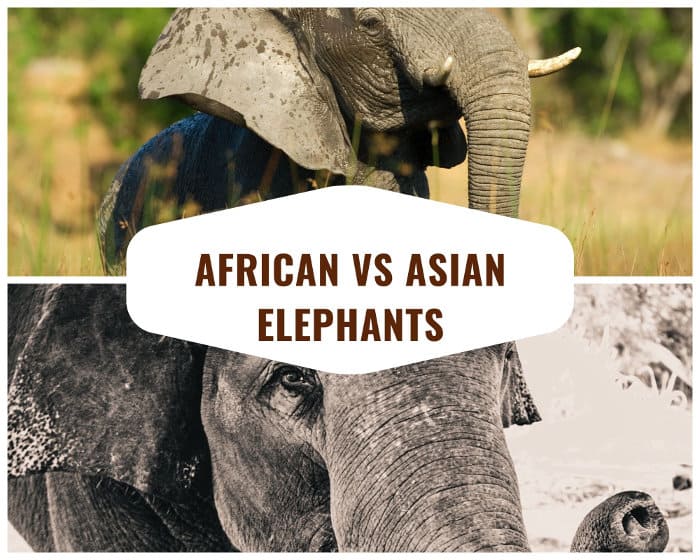
The two cousins are from different continents and have adapted to survive in different terrain. There are also differences in their genetics which makes it impossible for them to interbreed.
African elephants, other than being significantly larger than Asian elephants, also have more wrinkled skin in comparison to the smoother Asian elephant.
When looking at African vs Asian elephants, you can also tell them apart by their ears – African elephants have large ears that have a shape like Africa (as irony would have it). Researchers believe this helps them to cool themselves in the humid African climate. Asian elephants have smaller ears that have a shape like India.
There are other details, too. Their body shapes differ, with the Asian elephants having a more curved back. Only Asian elephant males grow proper tusks, yet African males and females both develop their famed ivory.
Another easy way to tell them apart? If you’re in Asia, you’re most likely seeing an Asian elephant. If you’re in Africa, you’re most likely seeing an African elephant!
If you were to see elephants side by side, then the easiest way to tell them apart is by how much they weigh. You don’t need scales to see how African elephants are the biggest of all the planet’s land animals.
Elephants Achieving Adulthood and Adult Weight

Like humans, elephants only emerge from their adolescent teenage years when they’re around 17 years old. It can sometimes take as long as 20 years for an elephant bull to achieve its full weight and height.
During these formative years, the elephant will remain with the herd. They get fed and tended to by their own mothers, however, they are also co-parented by the entire herd. Elephants have exceptionally close-knit family structures.
At the tender age of ten, many young bulls break away from the herd and form their own smaller groups. Scientists call these groups bachelor pods. Young females tend to stay with the herd. This phase will last for around seven years until the young elephants reach adulthood.
It is not until adulthood that elephants are ready to find a mate, despite them being sexually mature in a physical sense when they enter adolescence. So, how much does a full-grown elephant weigh?
How much does an adult elephant weigh?
The average weight of an elephant depends on its species. We know that the African elephant is the largest and that the males tend to be bigger than the females. The Asian elephant is slightly smaller than the African elephant.
An elephant’s growth is slow in comparison to most animals and even humans. Their gestation period is almost two full years (22 months).
The calves will then remain dependent on the mother for everything, from nutrition (they drink their mother’s milk) to hygiene. The mother is responsible for teaching the calves what the appropriate behavior, as well as survival skills, is.
An Elephant’s Early Years (As a 2-Ton Child)

Researchers say that the bond between a mother and a calf is exceptionally deep. The formative years in an elephant’s life are crucial for its survival. Moreover, they are also seen as an extension of their social habits – to nurture and to take pleasure in bonding.
In fact, baby elephants enjoy holding the tails of their mothers. This helps them to feel safe, much like human adults hold their children’s hands when they are walking.
For the first three years of its life, the baby elephant will source all of its nutrition from its mother’s milk. That said, weaning takes place in a very subtle sense at the end of the first year. Then some solid foods and vegetation will get introduced to their diet.
An elephant calf will continue to drink its mother’s milk for up to 10 years. This varies – some wean fully by three years while others wean even earlier when a new sibling arrives. Some elephants continue to drink their mother’s milk for ten years purely for comfort!
How much does a baby elephant weigh?
How many tons is an elephant at birth? A baby elephant weighs an enormous 77-113 kg (0.077-0.113 tons). Newborn elephants are tiny in comparison to their parents, weighing only around 2-4% of an adult’s size. They will consume roughly 11.4 liters of their mother’s milk each and every day.
Much like humans, elephants are born with an under-developed brain. Some researchers like to call their first few months out of the womb a final “trimester” – that’s if you want to use the same terminology applied to humans.
The underdeveloped brain of the newborn elephant makes it dependent on its mother, again, much like humans. A baby elephant’s brain is like a blank slate, and the mother has to equip that little one with everything it will need to thrive on its own (as part of the herd) one day.
How Much Does an Elephant Trunk Weigh?

An elephant’s trunk weighs around 140 kg (depending on the elephant), making it exceptionally heavy. The trunk is probably the most distinguishing feature of an elephant; it can hold up to 12 liters of water at one time.
The elephant uses its trunk for smelling, drinking water, breathing underwater, and picking or foraging for food. They also use their trunks as a hand – gripping and holding items with them.
The Asian elephant has one “finger” (a lip-like structure that helps it to hold onto items) on its trunk, while the African elephant has two as an adaptation to survive in their various habitats.
An elephant trunk is not complete at birth. Elephants are born with short trunks (in proportion to the rest of the body) which gradually extend.
An elephant’s trunk is also incredibly nimble and capable of lifting tiny objects. This dexterity is thanks to over 40 000 elephant trunk muscles that make the trunk fully functional. Considering the human body only contains a total of 639 muscles, this is seriously impressive!
How Much Do Elephant Tusks Weigh?

Elephant tusks are usually very heavy. Just how heavy is an elephant tusk? So heavy that you will struggle to even lift them off the ground. Male adult African elephant tusks typically weigh between 50 and 79 kg. The females’ tusks are slightly less prominent and smaller.
The heaviest tusk ever weighed was 102.5 kg. That’s a lot of ivory, so it’s easy to see why elephants are such a prize for poachers.
Tusks usually first emerge when an elephant is around two years old. They actually start as large incisor teeth which curve upwards and continue to grow.
They serve a number of important functions for elephants: they can assert their dominance, lift and move heavy items like bushes and small trees, and even comfort their young ones.
Impressive Elephant Eating Habits
The elephant’s ability to store fat and find sustenance is even more impressive when you consider that the food they eat is largely made up of cellulose.
Cellulose is the compound that makes up the cell walls in the plants that elephants eat. It’s a group of sugars, and while it is digestible, elephants need to eat a large volume of food in order to get the nutrients from inside those cell walls.
What do African elephants eat in a day?
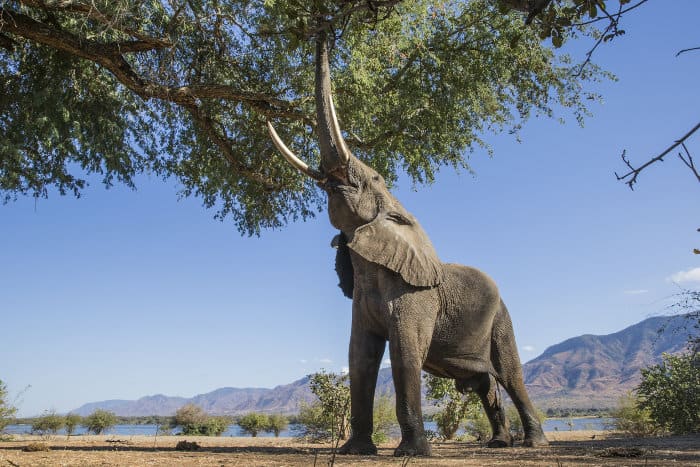
An elephant’s diet varies at times, although as herbivores, everything they consume is plant matter.
One of their favorite foods, perhaps considered a delicacy by elephants, is a thorn bush called an acacia tree. It has small green leaves, beautiful flowers and a yellowish trunk, yet its sizeable thorns are the most distinguishing characteristic.
African elephants are able to consume an entire acacia tree – everything – from the delicate leaves to the trunk, the thorns, and even the roots.
Elephants also love to find sweet fruits and green shrubs. Often, these are only available seasonally. Year-round, African elephants enjoy grasses, twigs, leaves, fresh green shoots, bark and vines.
African elephants will typically eat 4-6% of their body weight every single day in order to sustain that size. That translates to roughly 300 kg of food of mostly lightweight leafy greens.
Elephants usually wash down their daily intake with around 225 liters of water.
Elephant Teeth Are Completely Replaceable
Elephant teeth are also fascinating. They’re the perfect example of how various animals have adapted to survive in their own habitat.
Elephants don’t grow one set of baby teeth which get replaced by a new set as they enter adulthood. Instead, their baby teeth will remain until they get damaged or fall out.
An enamel cap covers their teeth to protect them, and they grow larger in proportion to the elephant’s body. The enamel cap eventually wears down. When a tooth gets lost or broken, a new one will simply replace it on demand.
A single tooth can grow back as many as 6 times in an elephant’s life. Each new tooth will grow back larger and stronger than the previous one.
How Heavy is an Elephant?
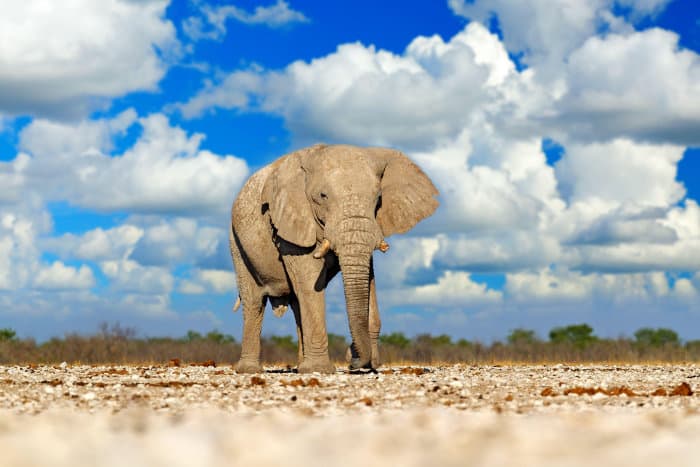
So now you know that the average elephant weight (in tons) is based on the type of elephant. How many tons does an elephant weigh? 6-7 tons for African elephants and 4-5 tons for Asian elephants.
For a chance to see these large, majestic animals up close, check out some amazing safari deals. Let’s hope we can preserve the wilderness so such majestic animals have space to thrive.
